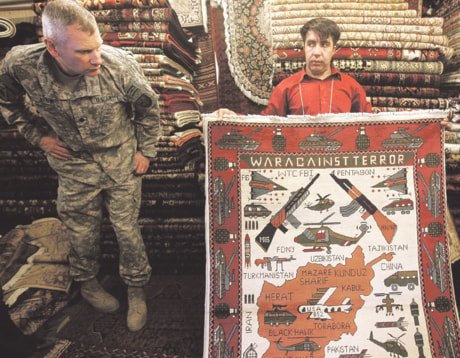KABUL — Amid piles of flowery and geometric carpets in an Afghan shop sits a pink rug of a Kalashnikov rifle framed by hand grenades. Another shows planes hitting a World Trade Center overlaid by Afghan and American flags.
Afghanistan’s three decades of fighting and insecurity have spawned a thriving “war rug” business for an international clientele of military buffs and soldiers. The carpets — which have moved from Soviet-era imagery to U.S. and NATO insignia — are a reminder that even war is a commodity in today’s Afghanistan, where so many are trying to profit from the billions pouring into the effort to stabilize the Taliban’s birthplace.
Afghanistan’s history has long been recorded by its largely uneducated people in stories and in carpets. When Soviet tanks rolled into Afghanistan in 1979, traditional woven scenes of hunters or village life gave way to Kalashnikov rifles, fighter planes and helicopters.
One such carpet shows the capital of Kabul under attack by planes and tanks. In another, a pattern of squat shapes reveals itself to be lines of Soviet tanks. A third carpet depicts a peaceful city scene, except for helicopters flying overhead.
Later, Afghans who fled to refugee camps in Pakistan started mass-producing images of Soviet weaponry for sale in the west, sellers say. Many of these are still sold around Kabul, although the designs have been updated. As one newer carpet proclaims in block letters: “NATO and ISAF forces fight against terrorists.” ISAF refers to NATO’s International Security Assistance Force.
The slogans are an attempt by the struggling rug industry in Afghanistan to draw more business from foreigners. Even though rug-making is a major trade, most weavers don’t have the machinery or the means to finish the rugs in country and have to send them to neighbouring Pakistan, says Zubair Ahmadi, who sells Afghan and other Persian rugs in California.
Ahmadi says he buys almost all his Afghan rugs from Pakistan because the poor water and electrical supply makes it hard to finish cutting and washing carpets in Afghanistan. Ahmadi has a weaving shop in Kabul, but even that shop sends its rugs to Pakistan for finishing.
“Afghanistan doesn’t have proper transportation, or a banking system that’s set up properly. And we don’t have a way of exporting directly from Afghanistan,” Ahmadi says.
The rectangular poster-looking rugs that run about $30 and show F-16 fighter planes or Chinook helicopters may be some of the few rugs that are woven and finished in Afghanistan. Seller Wahid Abdullah says most are made around the western city of Herat.
Their short labels laud the foreign effort: “FDNY” for Fire Department of New York or “Tora Bora” or “September 11, 2001” or “War Against Terror” or just “USA.”
Soldiers are major buyers of the rugs, says Abdullah, who carries a large selection of war rugs old and new. The most popular use of the small carpets? A doormat or bathroom rug.
At Camp Eggers, the U.S. base in Kabul, Lt.-Col. Kevin Holt says he has spent about US$3,000 on 15 war rugs during his Afghanistan deployment. The big money comes from the old Soviet-era carpets he bought, but he’s bought plenty of newer productions as well, hoping that they’ll gain value.
Not likely, says Brian Morehouse, a U.S.-based seller and appraiser.
“These rugs are not colour-wise technically wonderful. There’s nothing special about the rugs besides the ethnographic material,” he says. He adds that they should be seen more as folk art or as historical documentation than as works of fine art.
Holt acknowledges that he’s one of the more avid collectors on the base. He had read about war rugs before coming to Afghanistan and they were the first thing he asked about when he walked into Abdullah Ansari’s shop on the base.
“The holy grail for me is an AK-47 with the orange magazine,” Holt says, because those were used by Soviet special forces in one small area of Afghanistan.
Except for enthusiasts like Holt, most soldiers buy the small modern carpets.
“Every day we have people buying those,” says Ansari, the seller at Eggers. He says they’re cheap, and they’re keepsakes — even the World Trade Center rug.
